|
 |
<<< Back to History
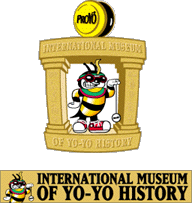
A Brief History of the Yo-Yo
|
In the beginning, there was a caveperson. He/she was a very bored person with most of his/her time spent on survival and little time for entertainment. Then, along came the invention of the wheel and people became mobile. This led to interactivity with their neighbors and, of course, yo-yo tournaments.
|
| Although we are
not sure how far back the yo-yo dates (see the other web pages
on the subject and you will see what I mean), we do know for
fact that they were around as far back as 400-500 BC in Greece.
Yo-yos exist in the Metropolitan Museum of Art (part of the
Fletcher Fund) from this period. |
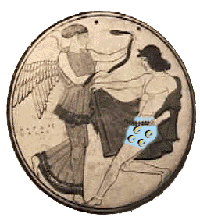 |

There are also in existence some Grecian
Urns from the same period with drawings depicting yo-yo
tricks such as walk the dog. |
| The next period in history that is documented is the Mayan era around 700 AD. There is supposedly a yo-yo from this period located in the Anthropological Museum in Merida on the Yucatan Peninsula. |
| The next period in history that is known is the late 1700's and early 1800's in France. Napoleon was known to carry and use a yo-yo (probably for stress relief). I would assume that he was a left handed yo-yo player as every picture I have seen of him depicts his right hand deftly tucked inside of his jacket, leaving only his left hand free. |
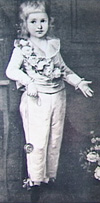
|
At roughly the same time (1789) we have the painting of King Louis XVII of France (painted by Mme. Vigee-Lebrun) which hangs in the Louvre in Paris and shows him with a yo-yo (also known as l'immigret). |
| November 20, 1866
James L. Haven and Charles Hittrick of Cincinnati Ohio received
the first patent for a yoyo in the United States. It
was for a yoyo "coupled together at their centers by
means of a clutch". It was also the first time
rim-weighting was mentioned in a patent. "It will
be observed that the marginal swell C, exercises the function
of a flywheel". The real importance
of this patent is that it suggests the first use of patents
to protect design improvements in the "Manufacture"
of a yoyo. This leads us to the conclusion that Messrs.
Haven and Hettrick were indeed in the business of mass producing
yoyos over a half century before Flores. The patent
also demonstrates the use of the terms "Bandalore"
and "Whirligig" |
 |
|
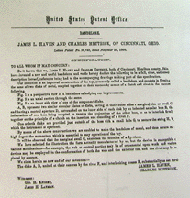
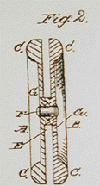
|
| After 1866, there
were a flurry of patents issued for such important features
as improved methods of attachment of the string to the "Wheel
Toy" (1867-John Syrcher), "concave" shape
(Aug 27, 1878-William Katz) and significant description of
the attributes of rim-weight (1906-Liebreich & Lothrop).
"outer spherical portion.....to provide the device
with more weight for increasing the efficiency of the operation.....". |
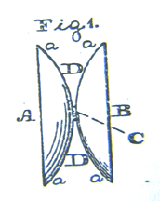 |
|
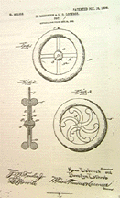 |
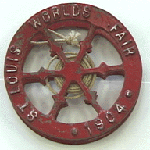  |
In 1904 at the St. Louis Worlds Fair, souvenir yoyos looked like this. Again demonstrating significant rim-weighting popular at that time.
Considered by most to be the oldest known "dated" yoyo. |
|
YoYos were quite popular in the Philippines in the early 20th century as toys. Any other rumors you hear or see about the yo-yo in the Philippines dating before this time fall into that notorious category of BUNK (kind of like Rocky and Bullwinkle's "Mr. Peabody's Improbable History") and should be duly ignored. What we do know is that a Filipino by the name of Flores did live in the San Francisco Bay area and did manufacture a toy labeled "Flores Yo-Yo" (YoYo is a Filipino word that means "Spring") in the 1920's.
|
| As the story goes, around 1927, D.F. Duncan Sr. saw a young man playing with one of the Flores yo-yos and saw a great potential for marketing the product. He worked for Flores marketing the product and, allied with newspaper tycoon William Randolph Hearst, he worked out a deal to get free (or very low cost) "white space" in the advertising sections of the newspapers in Northern California. |
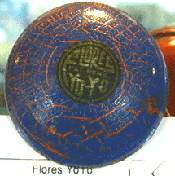
|
In return, the Flores company held competitions and the entrants were required to bring a quantity of new customers for the newspaper as their entry fee. In approximately two years, D.F. Duncan, Sr. bought out Flores and started the Genuine Duncan Yo-Yo company, subsequently trademarking the name "yo-yo". |
| As we all are aware,
looping causes the string to untwist/loosen (right handed
players) and twist/tighten (left handed players). In
1930 Mr. Leonard Powell of Kalamazoo, MI, came up with a cure
for this malady, the "Finger Ring with swivel". |
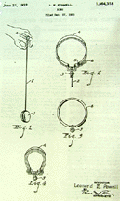 |
|
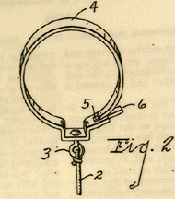 |
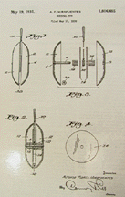
|
Also in 1930, Alphonso Flores Mirafuentes discovered the value of being able to take a yoyo apart. This was done with a bolt and nut, basically the same as most yoyo companies are doing it today. The Playmaxx variation on that theme being the addition of the "Lock Nut" to keep it from flying apart. |
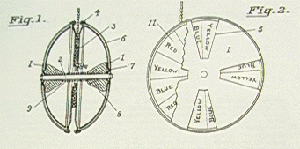 |
In 1934, E.S. Savage introduces
the design for the "Rainbow" as manufactured and
sold by Duncan. |
|
 |
|
| At roughly the same time, Louis
Marx (well know as a manufacturer of tin toys) started manufacturing
tin yo-yos in the United Kingdom under the "Lumar"
tradename. He made both standard (#33) and the original Lumar
whistling yo-yo. He later manufactured and sold in the U.S.A.
under the same name. |
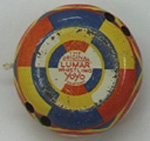 |
|
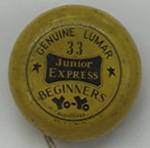 |
| The story as it was told to me by Donald F. Duncan Jr. when he gave me this 1939/40 prototype is that Duncan started working on a plastic yoyo in 1939 to 1940 with little success (it slept but it wouldn't come back). In 1941 WW2 broke out and plastic was a controlled commodity. All design efforts stopped. In 1945 they went back to making wood yoyos. About 1950, someone at Duncan came up with the idea of raised radially oriented ribs (starburst). That launched plastic yoyos and remained the best method of getting a yoyo to return until "Brake Pad Technology" in 1997. |
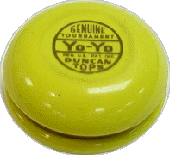 |
|
1940s
One of the original demonstrators for Duncan was Eddie Coo shown here with his wife Nina (ne: Mathewson). Photos courtesy of Jack Swanson (Eddies Nephew).
At the right is a brief letter of Jack's recollections of his uncle we would like to share with you. I have paraphrased the letter to conserve space.
|
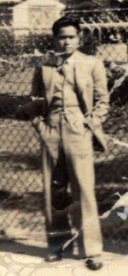
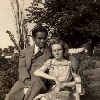
|
Dear Tom,
Eddie married my aunt Nina (Mathewson) back in the 1940's. It seems like they lived in either California or Florida at the time and I would see Eddie when they visited in Tulsa, so I never had an opportunity to know him well.
The thing I remember foremost about Eddie is that he was a sharp stylish dresser. He always looked dapper, wearing a suit and tie or sport coat and his black hair slicked down. He always seemed to be happy and at least acted like he genuinely enjoyed being around kids.
Eddie didn't actually work in the area where I lived (Tulsa, OK). It seems like his territory was on the west coast somewhere. However, he did always have a pocket or two of Duncan yoyos with him and, on every visit, he would give me one that he would carve with my name on it. He would carve a yoyo with all the palm trees, water, birds and my name in a matter of 2-3 minutes. It was amazing!
I don't recall Eddie standing around playing with a YoYo all the time, like you would think he would. He would only perform when specifically asked to and then only briefly.
I remember well that I was very proud that he was my uncle. All the kids in the neighborhood, I included, considered Eddie on the same level as a movie star. He was a "Performer"!
Yours Truly, Jack Swanson |
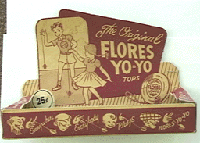
|
In the 1950's, Pedro Flores re-introduced the Flores trademark.
|
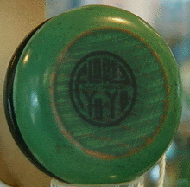 |
1959
Jack Sauer puts a ball bearing in a "yoyo doll". First known use of a ball bearing axle.
|
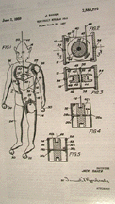 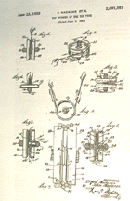 |
1959
E.Maderas patents an "Adjustable String Gap" yoyo. |
| In 1965, Milton Issacson puts a ball bearing in a "typical" yoyo.
Note the use of add on "weight rings" in FIG-6 to enhance the rim-weighted design. |
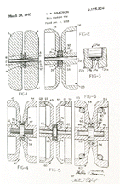  |
| Although "Starbursts" had been around for 15 years more or less, the first mention in a patent is by Joe Radovan in 1966. If anyone has definitive history on the invention of starbursts, I would be interested. Tom@KnackToys.com. |
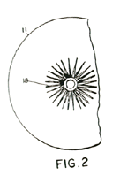 |
| The ProYo® was developed and patented in (1974). Playmaxx was started in 1976 by Donald F. Duncan, Jr. The original name was "Duncraft". This name existed for about 6 months and was changed to "Duracraft" at the request of the "Duncan YoYo Co." as they felt it was too close to their name/trademark. In 1988, Duracraft was changed to Playmaxx as it remains today. The original ProYo was produced until October 1996 when it was replaced by the ProYo II. The ProYo is considered, by aficionados, to be the father of most of the modern yo-yos. It is the most copied high tech yo-yo on the market today.
The main features of this yoyo were the central spool that set the parallelism of the two side members and the undercuts on the side members that allowed the use of advertising side caps. This was also an early example of the use of rim weighted design in a plastic yoyo.
Another significant feature (although not patented) was the shape. This "modern" shape is what has made it the father of the modern yo-yo.
"Copied by many, duplicated by none."
Above right is the original Duncraft ProYo as produced in 1976. The middle is a Duracraft ProYo. This was produced unchanged except for the name until 1996. The bottom picture is the screw, axle and nut used in the Duracraft/Playmaxx version. The far right axle was the wood axle used by advanced players in place of the brass axle.
|
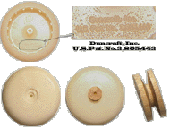
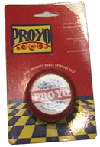

|
| In October of 1996, with the introduction of the ProYo II, Playmaxx yo-yos rapidly became the hottest selling high performance yo-yo around the world. It was an instant success in Australia, New Zealand, Singapore, Japan, United Kingdom, Poland, Greece, Norway, Sweden, Italy, Finland, Canada, Denmark and many other countries.
The ProYo II axle design was also patented as well as several other features like the ability to display POGs in one side.
The bottom picture is the ProYo II axle design. It is like having a miniature wood one-piece yoyo mounted inside a rim-weighted plastic shell. Therefore, bringing together the best of both worlds, wood and plastic. |
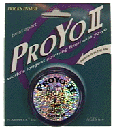 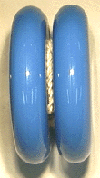

|
| In October of 1997, Playmaxx introduced the perfect "Bumble Bee" ball bearing ProYo. The perfect yo-yo should SLEEP for an inordinate amount of time, "BEE" absolutely smooth on string tricks without snagging, and return on command without hesitation. This describes the new Turbo Bumble Bee, the only ball bearing yo-yo that performs "right out of the box", requires NO string gap adjustments and is independent of string tension.
There have been three "Bee" patents issued so far (two in September 1998 and a third in 1999). |
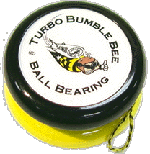
|
| Also in October of 1997, Playmaxx re-introduced the Vid-e-Yo training video. This was produced as a joint effort by Playmaxx and TimeLine Video. TimeLine Video is a professional video company in New York that specializes in training videos. The Vid-e-Yo stars U.S. and World ProYo Master Yo-Hans. The video won the coveted 1998 "Aurora" award for "Platinum - Best of Show". The picture (far right) is of Yo-Hans and Ed Guiletti with the award. |
|
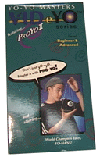 
| Enhancing the use of Brake Pad technology, Playmaxx introduced the Cold Fusion in October of 1998. This rapidly became the most sought after aluminum yoyo around. Sales, at $150.00 each, considerably outran expectations. |
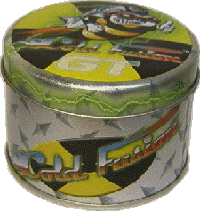 |
All three of the acknowledged world records for yo-yos with fixed axles as listed by the
American Yo-Yo Association (AYYA) are held by the ProYo by Playmaxx.
Longest spinner - to extinction : 51 seconds - ProYo
Fastest spinner : 11,400 RPM - ProYo
Around the Worlds : 26 - ProYo
Now the Worlds Record for sleep time has been SMASHED by the Cold Fusion.
October 3rd at the US National Championships, the Cold Fusion slept for an unprecedented 7 minutes and 8 seconds.
On May 16, 1999, at 7:10 PM Kate Miller broke the World Sleep Record of 7:08 with a time of 8 minutes and 21 seconds in the company of the staff from Golden Apple Comics. Time was witnessed and verified on two separate chronographs.
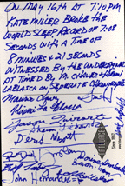
This record was summarily beaten by Matt Owen at 10 minutes and 18 seconds at the Fourth Annual World ProYo Championships in Mesa Arizona on 18 July, 1999.
|
|
|
| |
Copyright 1998-2002 Tom Van Dan Elzen
|
|
 |
|
|
 |
 |
|

